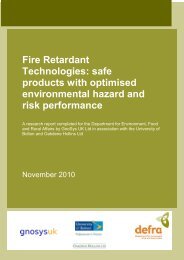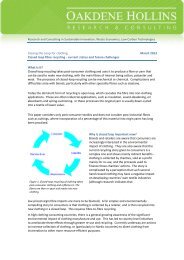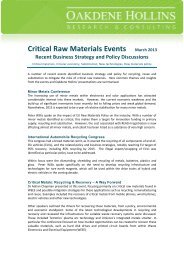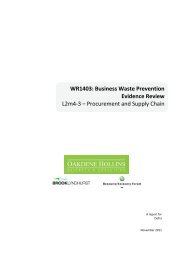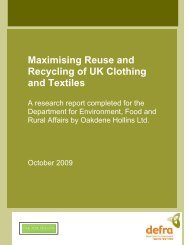Recycling of Low Grade Clothing Waste - Oakdene Hollins
Recycling of Low Grade Clothing Waste - Oakdene Hollins
Recycling of Low Grade Clothing Waste - Oakdene Hollins
You also want an ePaper? Increase the reach of your titles
YUMPU automatically turns print PDFs into web optimized ePapers that Google loves.
© <strong>Oakdene</strong> <strong>Hollins</strong> Ltd, Salvation Army Trading Company Ltd<br />
Nonwovens Innovation & Research Institute Ltd September 2006<br />
The implications <strong>of</strong> this for the secondary textiles sector is that lower<br />
quality, items are being collected, and there is a reduction in the sales value<br />
<strong>of</strong> the wearable items. The consumer has to choose, say, between a new<br />
shirt, now available at £5, and a second‐hand shirt at £3. When the new<br />
item was above £10, it was easier to make the decision in favour <strong>of</strong> the used<br />
item. In addition, the re‐saleable proportion <strong>of</strong> the collected items is<br />
declining, meaning that increasing quantities have to be recycled, or<br />
disposed <strong>of</strong> to the waste stream, at a cost to the collector or merchant.<br />
These trends in volumes and prices are likely to accelerate as a result <strong>of</strong> the<br />
cessation <strong>of</strong> the World Trade Organisation (WTO) Multi‐Fibre Arrangement<br />
(MFA) in January 2005, especially when the current transitional<br />
arrangements are exhausted. China and India will dominate the<br />
production <strong>of</strong> new textile materials and products through major vertical<br />
integration programmes. Both economies produce high technology, high<br />
quality fabrics and have low garment production labour costs. Pacific Rim<br />
Multi‐Fibre Alliance countries such as Indonesia, Cambodia and Vietnam<br />
will increasingly rely on Chinese fabrics, and manufacturing will suffer<br />
here when the market is fully freed up. China and its ‘satellite’ countries<br />
will be used more for the long run, stable designs such as jeans, tops,<br />
T‐shirts and underwear, with the less predictable, low cost fashion items<br />
more likely to come from North Africa, Italy and Turkey.<br />
Whilst China sees its participation in the textile industry as ‘transitory’, i.e.<br />
that they will want to be out <strong>of</strong> it in, say, 20 to 30 years time, the changes<br />
that they will cause in the world textile market are seen as irreversible. The<br />
belief in the industry is that prices will drop a further 30% from today’s<br />
levels when China is supplying the market free <strong>of</strong> import restrictions.<br />
Whilst all figures must be treated with caution, because <strong>of</strong> the changes in<br />
fashion during the last ten years, it is the trends in the market place that are<br />
irrefutable.<br />
This activity in the new clothing market will further weaken collection<br />
economics and depress the sales and margins <strong>of</strong> second‐hand clothes. All<br />
<strong>of</strong> these problems, which affect the charity shop and commercial textile<br />
recyclers, have been widely reported in the national and trade press.<br />
For Defra Page 21



